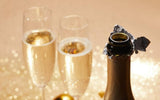
Keeping Champagne Bubbly: Best Storage Methods For Opened Bottles


You've just opened a bottle of Champagne. You pour it into your Champagne glass and marvel at how the bubbles nearly overflow. But when you can't finish the entire bottle in one night, you might be worried that all those bubbles will be gone along with the lovely flavors.
Save yourself from this dismay with these helpful methods and tips on storing opened Champagne and keeping it bubbly. The best way to store leftover Champagne is to seal the bottle properly and place it in the right conditions.
You can also try other methods to keep opened Champagne fresh for a time and help retain the carbonation. If you want to enjoy your best Champagne until the last drop, read on!

Cork - If you don't have a stopper, you can substitute it with a wine cork. You have to use a still wine cork rather than a Champagne cork since the former is not tapered, making it fit in the bottle's mouth.

Here is a video for a visual demonstration:


You can watch this video to learn the process of using a perlage system better:

When storing unopened red wines or white wines, the bottles are commonly placed horizontally or on its side to keep the cork moist.
However, the circumstances are quite different when it comes to Champagne. In storing it for a short period, you can place it horizontally or vertically as it will not really affect the drink.
Some wine experts advise storing your bottle upright. This is one way to prevent cork taint, which produces an odd odor and bad taste.
In this case, there's no need to worry about the cork being dried out and cracked because the Champagne bubbles can help keep the cork humid. Note that this is only applicable for short-term storage.
Nobody likes to drink flat Champagne, so keeping it chilled is the key to ensuring it remains fizzy. Another reason is when Champagne is exposed to heat, it tends to mature faster and alter the taste.
After resealing the bottle, place the bottle in an area with a consistent temperature, like a wine fridge, and make sure the temperature is around 47 to 50°F.
When you're about to pour the Champagne, you can transfer the bottle into an ice bucket filled with ice and cold water. Let it chill for about 30 to 45 minutes.
To keep your sparkling wine fresh and safe, it's best if you have an area where there are no strong smells, vibrations, or bright lights.
The smell could attract insects, vibrations could damage the bottle, and the light may greatly affect the fine fruit aromas and other Champagne flavors.
The ideal place to store Champagne properly is in a cool, dark space with just enough humidity. This is best applied with unopened bottles, but you can also implement this tip even for short-term storage with opened bottles.
Vintage bottles of bubbly from prestigious Champagne houses are often considered high-quality Champagne. Granted, they are more expensive, but they give you better storage opportunities as they don't go bad quickly.
The Champagne grapes as well as the process used to produce high-quality sparkling wine, are among the factors of why it lasts longer. They also tend to keep their bubbles longer than cheap Champagnes.
If you don't have Champagne stoppers on hand, you can try this simpler method when storing leftover sparkling wines.
To help keep Champagne bubbly overnight, you can try covering the mouth up to the neck of the bottle with plastic wrap or aluminum foil. Then, take a rubber band and tie the plastic wrap or foil around the neck.
This pretty easy insulation hack creates a cold air plug and avoids flat Champagne.
There has been a lot of talk about how letting a metal or silver spoon dangle in a Champagne bottle helps keep the Champagne bubbly.
However, despite this method's popularity, many experts have already performed experiments on it and concluded it to be a myth.
So, it is better to invest in a good Champagne stopper if you intend to drink your Champagne the next few days and expect it to be still bubbly.
Champagnes may be sparkling "wine," but it isn't like red wines and white wines that get even more delicious over time. Eventually, they will spoil, which is why you need to know their shelf life.
It is important to note when you've opened a bottle of Champagne, the countdown of its shelf life starts. Generally, Champagnes can last for 2 to 5 days, depending on the type and storage conditions.
But, if you use the Perlage system, the sparkling wine will most likely last for at most 2 weeks.
Though we never plan on having any leftovers, sometimes they happen, and you're left with half bottles of bubbly. But they can be a real treat if you know what to do with them.
You don't have to pour them down the drain and feel guilty for wasting good quality Champagne. Instead, you can repurpose them! Here are some foods and drinks you should absolutely try:
The next time you've opened too many bottles and end up with some left, there's no need to go through a headache of figuring out how to save leftover Champagne.
With the proper storage techniques, you can enjoy your bubbly over an extended period and avoid wasting Champagne overall.
Did you like this article? If you did, please share it with your friends on social media! And don’t forget to leave us a comment below, letting us know which storage method is your favorite.

